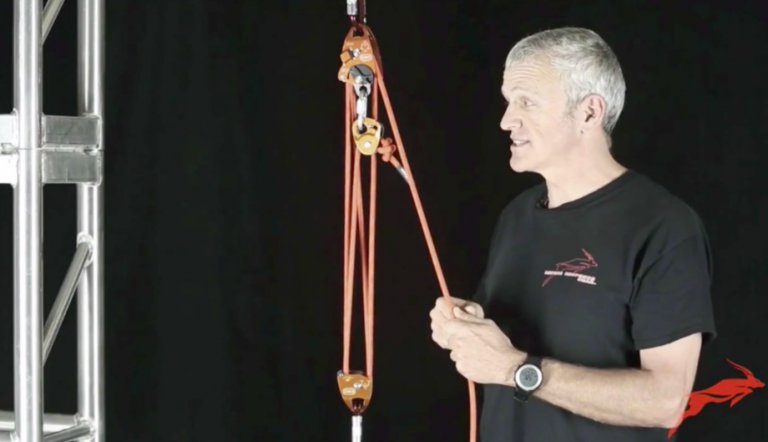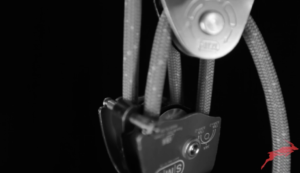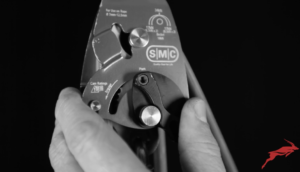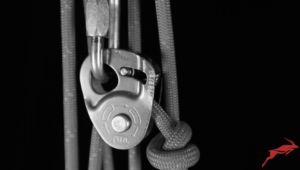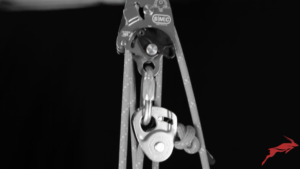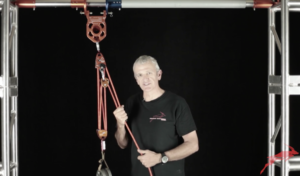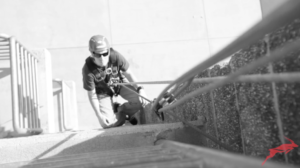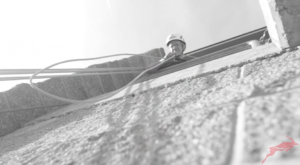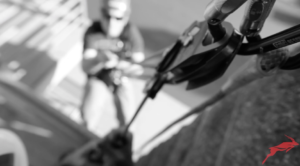What has happened… a worker has fallen from his working platform. The worker condition is good enough where he is able to assist in his own recovery and rescue.
This video was developed over a span of time where Rich took to heart, the process of confined space rescue, fallen worker rescue and simply using what you have on your belt. The Fast Fours concept is evolving over time and even now… modifications have taken place to make this system smaller and more compact.
Fast Fours Mechanical Advantage System
The Fast Fours is a simple variation on a standard set-of-fours. The difference is that the far end of the rope is not terminated on the becket of a pulley. Instead it is run through another progress capture pulley. This means that an operator can either pull on both ends simultaneously to yield a fast take up 2:1 or a single strand for a 4:1.
There is another unique advantage of this system for fallen worker and confined space recovery. If capable, the fallen worker can pull on one end of the system while the rescuer pulls on the other which speeds the recovery, halves the individual work, and involves the victim in the task.
Hi, I’m Richard Delaney from Rope Lab in the Blue Mountains of Australia, and I’m working with the Rigging Lab at Rescue Response Gear. What I’d like to do is introduce a variation on the set of fours, this is the Fast Fours. It’s still in this configuration the same as a standard set of fours, where for one unit of tension that I applied the input, I get four units applied to the load. So it’s a four to one system of mechanical advantage. The big difference with this setup though, is rather than having the far end of the rope terminated at the becket on this pulley, I’ve got it terminated through a Petzl MicroTraxion. Now the pulley at the top here is an SMC Advance Tech HX which has progress capture on the shiv on this side. But what it means is I’ve got two free ends of rope, so rather than just being a standard set of forwards, which is four to one, I can grab both of these strands and pull together as a two to one, which brings the load up much more quickly. Then when it becomes too hard or too loaded, I can go back to pulling one strand as the four to one.
With the Fast Fours a really neat application is if I just run the load back out to full length and I’ll drop it down even further. Pretend this is a fallen worker on a work site or a worker in a confined space that needs recovering. If I send that right down to them, I can then also send them the long end of this rope and get them to haul on that strand while I haul on this end. We can work together and it doesn’t even matter if we’re pulling at different rates, it halves the work that I have to do to get that person out because they’re, if capable, able to do half the work as well. So we can get them out much more quickly.
With the Fast Fours a really neat application is if I just run the load back out to full length and I’ll drop it down even further. Pretend this is a fallen worker on a work site or a worker in a confined space that needs recovering. If I send that right down to them, I can then also send them the long end of this rope and get them to haul on that strand while I haul on this end. We can work together and it doesn’t even matter if we’re pulling at different rates, it halves the work that I have to do to get that person out because they’re, if capable, able to do half the work as well. So we can get them out much more quickly.
Peace on your Days
Lance

